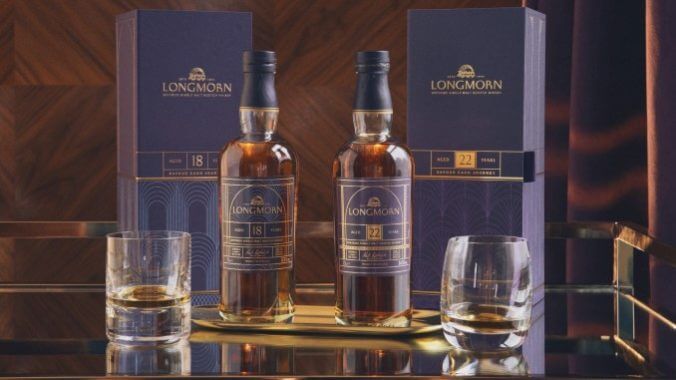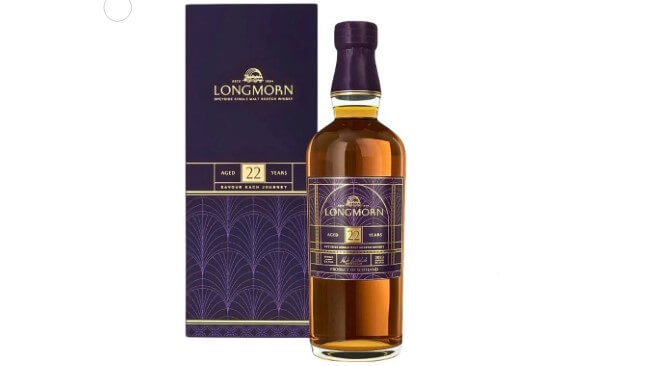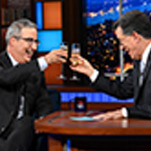Tasting: 2 Single Malt Scotch Whiskies from Longmorn (18, 22 Year)
Photos via Longmorn, Pernod Ricard
The American consumer of scotch whisky has come to be conditioned, at least to some degree, by how the average Scottish whisky distillery tends to construct a product lineup. A new brand entering the market can usually be expected to have a modestly aged, mid-shelf flagship single malt: A 10-year-old, a 12-year-old, etc. Or they may deemphasize age statements altogether by embracing the last decade’s trend toward non-age-stated entry level single malts, some of which tend to undergo secondary maturations or even see time inside newly charred oak, breaking with scotch whisky tradition. One thing you don’t ever really see is a distillery entering the market for the first time by exclusively offering advanced age statements and luxury price points. And that makes Longmorn an immediate, interesting oddity, because they’ve done exactly that.
Longmorn isn’t a name that will be particularly well recognized by U.S. scotch whisky geeks, largely for the fact that they’ve rarely had any expressions of their own over the years. The distillery has been in operation since 1893, but like so many other classic Speyside distillers the majority of their history has been as the maker of malts used in major scotch whisky blends. Ownership has fluctuated over the decades, as Longmorn was acquired by The Glenlivet Distillers Ltd. in 1970, which was bought by Chivas Brothers in 1978, and itself absorbed by Pernod Ricard in 2001. Most of the Longmorn distillate that drinkers have encountered has been as a backbone, unsurprisingly, of various Chivas Regal blends.
But now, they find themselves in the spotlight, standing on their own with a profile of two new luxury expressions that take advantage of the distillery’s deep stock of aged whisky. Longmorn 18 Year Old and Longmorn 22 Year Old are both intended for the U.S. market, taking square aim at the ultra-premium segment–a bold choice for a brand with little name recognition. Both are bringing the whisky geek bonafides, though, being non-chill filtered and presented at impressive cask strengths. Both also say they are “matured primarily in American oak casks,” which is an interesting way to put it–does “primarily” mean there are some European (sherry, port?) casks in there? Or just the possibility of seeing them in the future? The distillery says these single malts are “aged in a careful curation of barrels and hogsheads to express a luxurious new depth of flavor,” with the reference to hogsheads in particular making me think there must be at least some European oak involved here. Regardless, this is a brand still asking a lot from consumers, to take a plunge on a $280 or $440 bottle without much experience with what Longmorn is all about.
So with that said, let’s get to tasting these two expressions and see how they measure up.
Longmorn 18 Year Old
ABV: 57.6% (115.3 proof)
MSRP: $280

This 18 year old expression of Longmorn’s single malt weighs in at quite an impressive 115.3 proof, surprisingly high for a Speyside single malt with that kind of age statement, given the tendency of many whiskies aged in the cool climate of Scotland to lose strength over the course of their maturation. Suffice to say, I haven’t seen this combination of age and proof for a while.
On the nose, this one is redolent in deep toffee sweetness and baked apple fruitiness. I’m getting honeycomb with slightly toasty characteristics and more than a hint of wood spice and licorice, supported by butterscotch. On the palate, it really revels in the rich toffee and spice, featuring heavily caramelized and slightly nutty sugars, vanilla, Christmas cookies and griddled apples. There are faint traces of grassiness and a bit more earthy notes that hint at the original character of the younger spirit, but they’re pretty subtle. Texture is lusciously full and smooth, pairing well with a moderate level of residual sweetness that leans toward the rich without being overwhelming.
Heat, unsurprisingly, is definitely present and sturdy, giving the baking spice more of a hot pepper dimension. This is boldly flavorful in general, with a level of punchiness that had me looking up the ABV to check it once again, but by no means is this too hot for most any regular scotch consumer. The overall profile is very tasty, celebrating the toffee richness and cooked fruitiness of the spirit. A very flavorful dram indeed.
Longmorn 22 Year Old
ABV: 54.5% (109 proof)
MSRP: $440

The 22-year-old expression of Longmorn holds a similarly high proof point but features another drastic jump in MSRP–looking at those numbers, you have to inherently question if another four years in the casks are going to really result in a dramatic change the consumer perceives as being worth the additional $160. These are not small dollar figures. It makes me wonder if in addition to the higher age statement, this expression is also calling on different styles of casks in order to help it stand apart from Longmorn 18 Year Old.
On the nose, the 22 Year Old presents with drier notes of aromatic oak and nutty cocoa. There’s a decidedly less rich and sweet approach here, replacing some of the fresh and candied fruitiness of the 18 Year Old with more of a dried fruity and nutty character, somewhat vinous in nature.
On the palate, these impressions carry through and do indeed stake a claim to this being a significantly different profile than the 18 Year Old. I’m getting significant nuttiness and milk chocolate here, with vanilla cream and expressive dried dark fruit and vinous tones. Sweet oak spice and increased oak tannin dry out the sip slightly. There’s so much nuttiness and winey fruit, in fact that it almost seems like something influenced by PX sherry casks. This profile in general is not as purely flavorful or explosive as the stronger 18 Year Old, but is instead deeper, dark and quite soulful. This is the more contemplative dram–the kind of scotch that people who don’t drink scotch imagine someone is drinking in a hunting lodge in a high-backed leather chair in front of a roaring fireplace. Call that romanticism, but it’s the image that is conjured up by this profile.
With that said, I think perhaps the 18 Year Old expression may be the more popular among enthusiasts for its more assertive overall flavor profile. Time will tell if they can find their market in the U.S., but these are some nicely matured malts from a distiller that will now be afforded significantly more respect.
Jim Vorel is a Paste staff writer and resident brown liquor geek. You can follow him on Twitter for more drink writing.






































